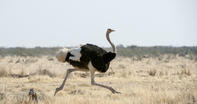
Name
Ostrich - Struthio camelus.Appearance
The ostrich is a member of a group of birds known as Ratites. They are flightless birds without a keel to their breastbone. They are very fast runners and can maintain an average speed of 50 km/h. Of the 8,600 bird species which exist today, the ostrich is the largest.
They weigh 100-135 kg and can cause serious injury and death with a kick from its powerful legs. The ostrich has a long, curving, predominantly white neck and very large eyes (50 mm).
The beak is flat and broad with a rounded tip. They have long, bare legs and stand tall at an average height of about 2.1 m. The humped body of the male is covered in black patches and the wings and tail are tipped with white. The female is brown and white.
Ostrich Diet
Ostriches are mainly vegetarian, eating grass, succulents, berries and seeds. They will also eat insects. They swallow large numbers of pebbles which help grind the harder food in the gizzard and aid digestion.Ostrich Breeding
Ostriches normally mate for life and share the task of incubating the eggs. Ostriches form bisexual groups with a complex structure. Territorial males compete for flocks of 3 to 5 females.
Mating includes elaborate displays of hisses and dancing. Once divided into mating groups, ostriches in some areas use communal nests to hold anywhere from 14 to 60 eggs. The nest is a hole scraped in bare ground about 1 to 2 feet deep. Ostrich eggs is the largest of all eggs and are 15 cm long, 13 cm wide and weigh 1.4 kg. It is shiny and whitish in colour.
The eggs take approximately 35 - 40 days to hatch. The male, which has mostly black feathers, sits on the eggs at night and the drab, brown female covers them during the day. In this way, the nest is much harder to see.
Contrary to popular belief ostriches do not bury their heads in the sand. If threatened while sitting on the nest, the female presses her long neck flat along the ground, blending with the background. Once the chicks hatch, it is usually the male ostrich which looks after them until they are old enough to fend for themselves.
The Domesticated Ostrich
Ostriches were almost wiped out in the 18th century due to the hunting for their feathers. The movement changed from hunting to domesticating and plucking ostriches.
By the middle of the 19th century, the extensive practice of ostrich farming has increased the ostrich population. Ostriches have been successfully domesticated and are now farmed throughout the world and particularly in South Africa for meat, feathers, and leather.
The leather goes through a tanning process and is then manufactured into fashion accessories such as boots and bags.
 SouthAfrica.co.za provides informative, educational content on many South African bird species that orthologists and bird-watchers would enj...
SouthAfrica.co.za provides informative, educational content on many South African bird species that orthologists and bird-watchers would enj... Ostriches are the only birds, and animals except for camels, that do not exhale moisture-saturated breath like other creatures. The long nec...
Ostriches are the only birds, and animals except for camels, that do not exhale moisture-saturated breath like other creatures. The long nec... Oudtshoorn is the largest town in the little Karoo. Oudtshoorn is also home to one of the world's greatest wonders, the magnificent Cango Ca...
Oudtshoorn is the largest town in the little Karoo. Oudtshoorn is also home to one of the world's greatest wonders, the magnificent Cango Ca... Ostriches are the largest and heaviest living birds in the world standing two and a half metres tall and weighing in at 150 kg (large males)...
Ostriches are the largest and heaviest living birds in the world standing two and a half metres tall and weighing in at 150 kg (large males)... Courtship in ostriches is a spectacular affair. The males acquire scarlet colouring on their beaks, foreheads, necks and shins. They chase e...
Courtship in ostriches is a spectacular affair. The males acquire scarlet colouring on their beaks, foreheads, necks and shins. They chase e...